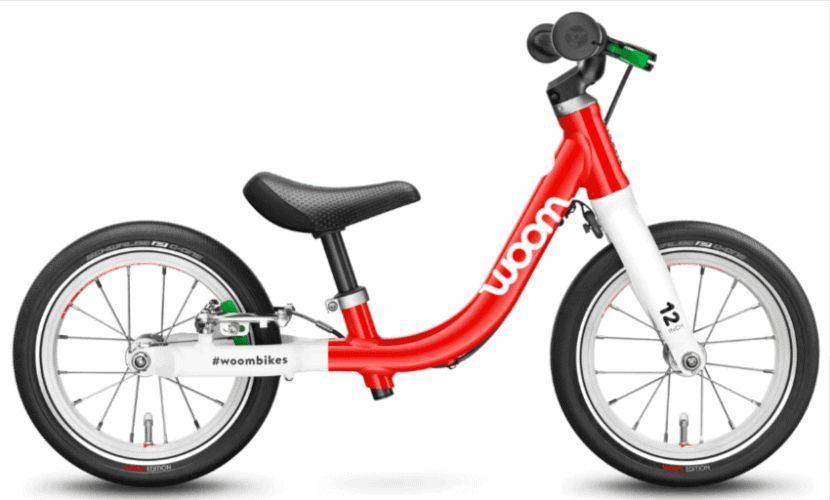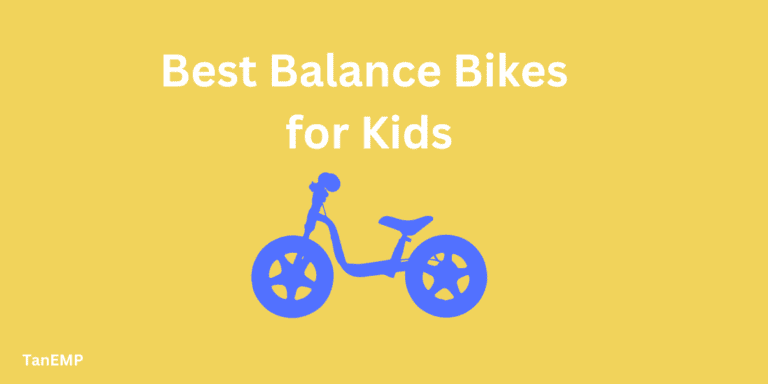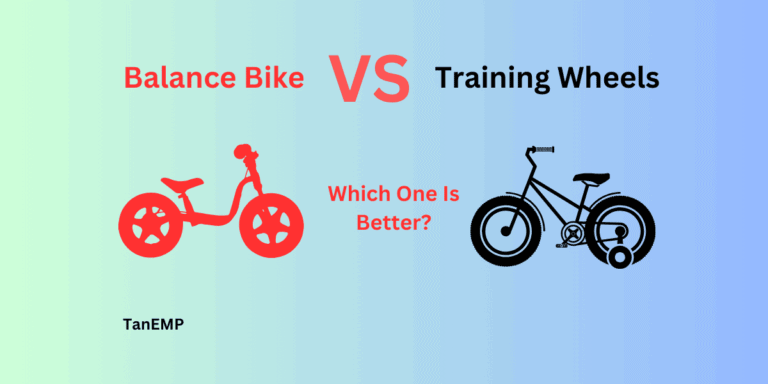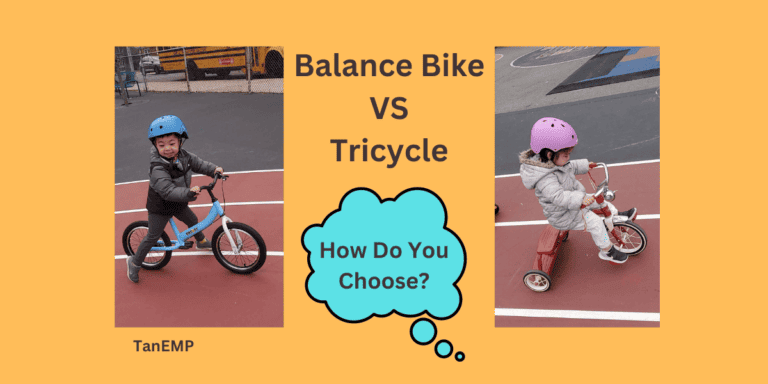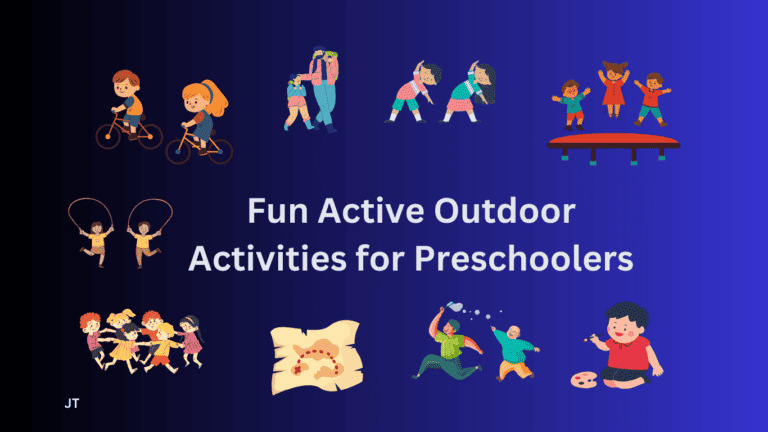How To Ride A Balance Bike – 7 Easy Stages
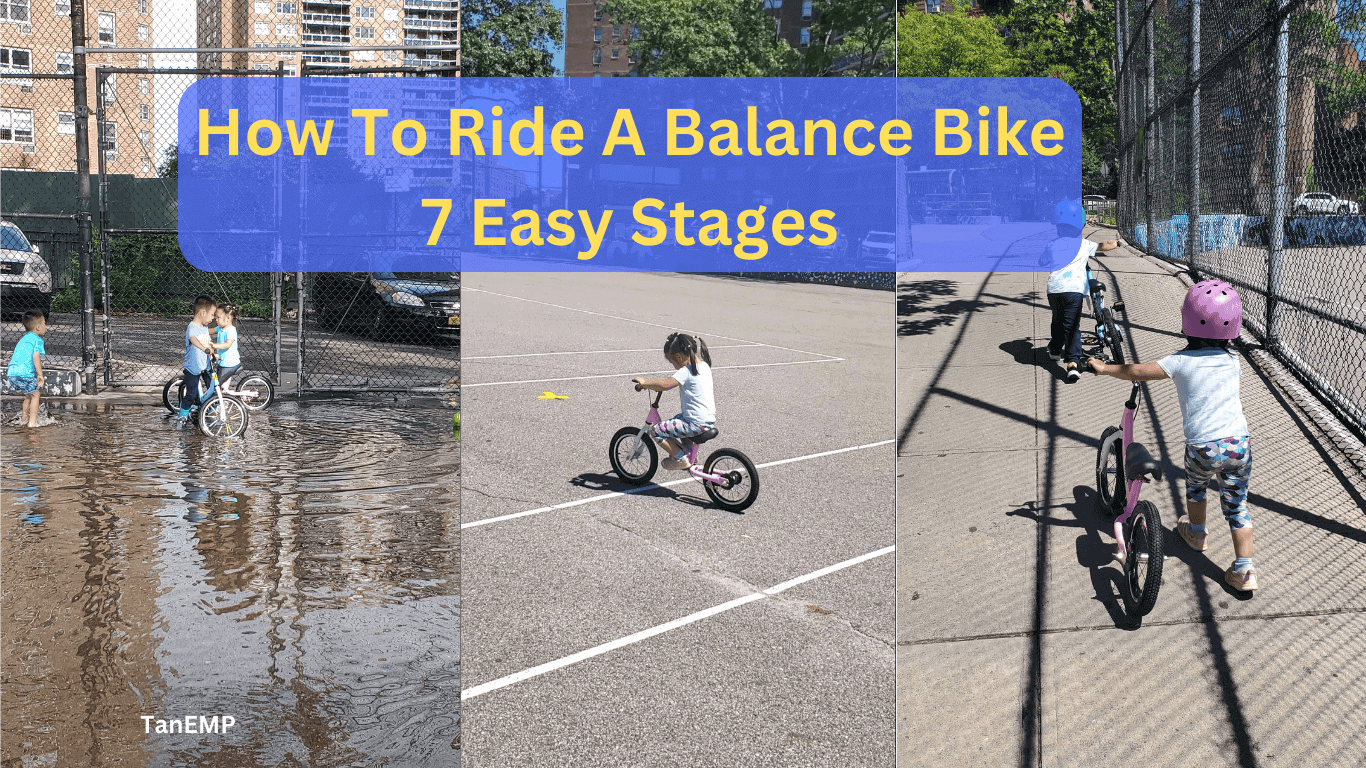
Learning to ride a bike can be a scary experience for kids.
While training wheels offer a sense of security, the challenge arises when it’s time to transition to riding without them.
The truth is, that removing the training wheels might not magically turn your child into a confident, independent rider.
You may still need to hold on to the bike until they’re ready to ride without assistance.
Many parents may ask, how can we provide a seamless stepping stone for our kids to naturally master bike riding without the safety net of training wheels?
This is where the balance bike comes into play.
Balance bike is the solution that allows your kids to master balance, steering, and building confidence before graduating to pedal bikes.
However, parents are often unsure what age children can start using a balance bike, the proper size and set one up, and techniques for teaching kids effectively.
I learned how to ride a bike the hard way from many falls and cuts, and even better, I started with a training wheel first.
I don’t want my son to go through my experience so we introduced balance bikes at 2 and 1/2 years old, and he was pedaling at 4 years old.
Drawing from personal experience, particularly with our son’s successful journey from a balance bike to a pedal bike, this guide aims to provide a comprehensive overview of balance bikes.
We understand the frustrations of teaching bike riding and share our insights to help parents introduce their children to the joy of a balanced bike.
Key Takeaway
- The ideal stages and age range for mastering a balance bike
- Pro tips to properly size and set up their balance bike
- Techniques for teaching balance, gliding, stopping, and more
- Tips to transition to a pedal bike smoothly
- How to foster confidence and independence in their biking journey
By following this comprehensive guide, you’ll feel empowered to get your child to ride a balance bike successfully. So let’s get started!
What is a balance bike?
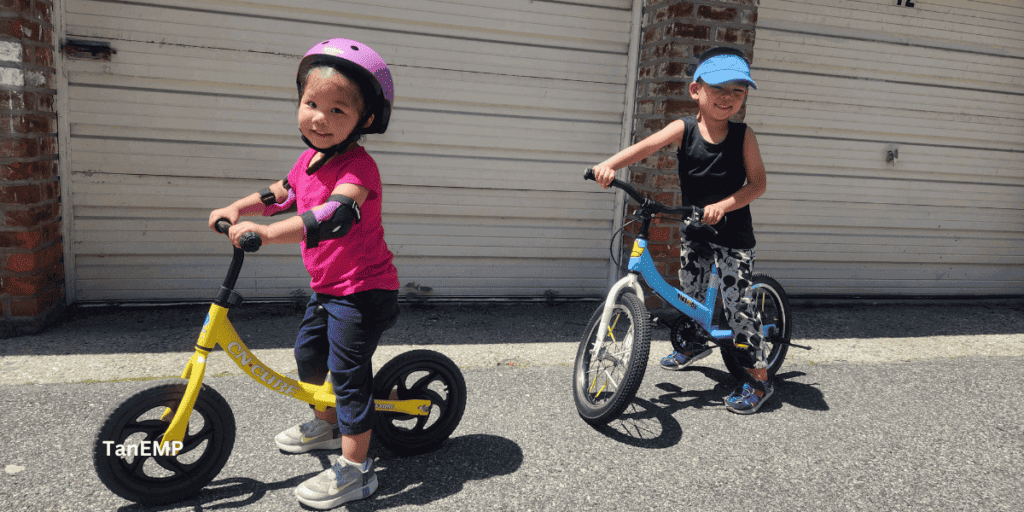
A balance bike, sometimes called a running bike or push bike, is a balance bicycle without pedals. It is designed for children from 18 months to 5 years old.
Balance bikes have several benefits over traditional bikes with training wheels for beginning riders.
It helps kids to have an easier learning curve by improving their balance and steering before focusing on pedaling.
Young kids can begin riding a balance bike as early as 18 months old.
Once children have mastered balance biking in any terrain and gained skills such as striding and gliding, they can begin the transition to a pedal bike without a problem.
7 Stages of Mastering a Balance Bike
Riding a balance bike allows children as young as 18 months to start developing coordination and learning how to balance.
However, there is a learning progression that kids tend to follow as they gain coordination and confidence on two wheels.
Knowing these typical stages helps you know what to expect and how to support your child’s development. Inadequate advancement may delay their development.
Most kids master balancing and steering well before they acquire the coordination needed for pedaling. That’s why balance bikes are the perfect choice for laying that critical foundation for child ride adventures.
Now let’s explore the key stages of skill-building on a balance bike:
1. Stand and Stroll (18 months to 3 years)
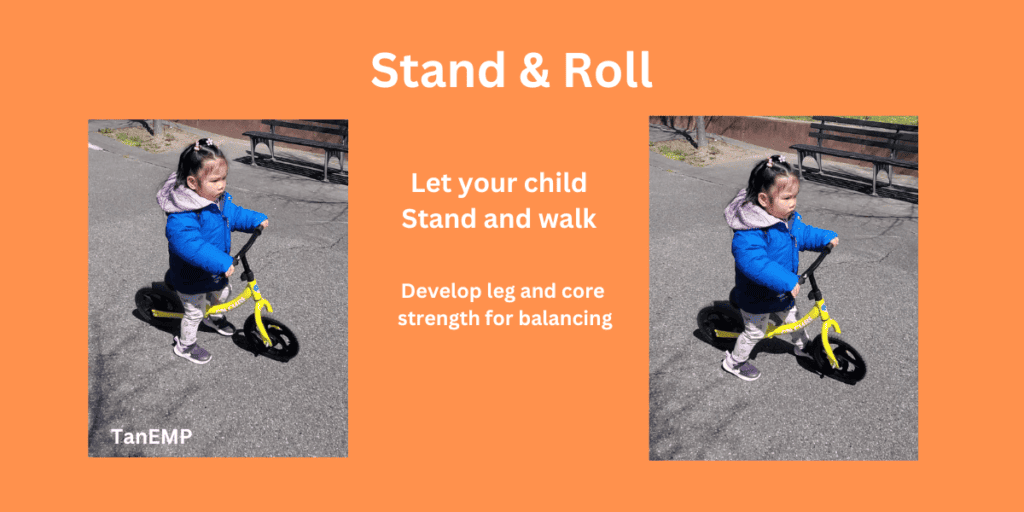
The first stage of balance bike mastery is all about building confidence through exploration.
From around 18 months to 3 years old, let your child stand up on their bike and walk it around slowly while maintaining their balance.
Make sure to use a proper balance bike meant for 18 months old such as the Woom bike.
Stay close by and offer encouragement. They will wobble and tumble during this stage. It’s best to start at home or the park with rubber flooring to brace their fall.
At this point, steering doesn’t need to be perfect. They should focus on developing strength in their legs and core muscles to keep the bike upright.
Have them practice pushing the bike with their feet, walking next to it, then coasting a bit. This stage lays the foundation before they ever put their bottom on the seat.
- Encourage standing and walking to build confidence
- Provide Positive encouragement for their small success
- Develop leg and core strength for balancing
2. Sit and Roll (2 to 3 years)
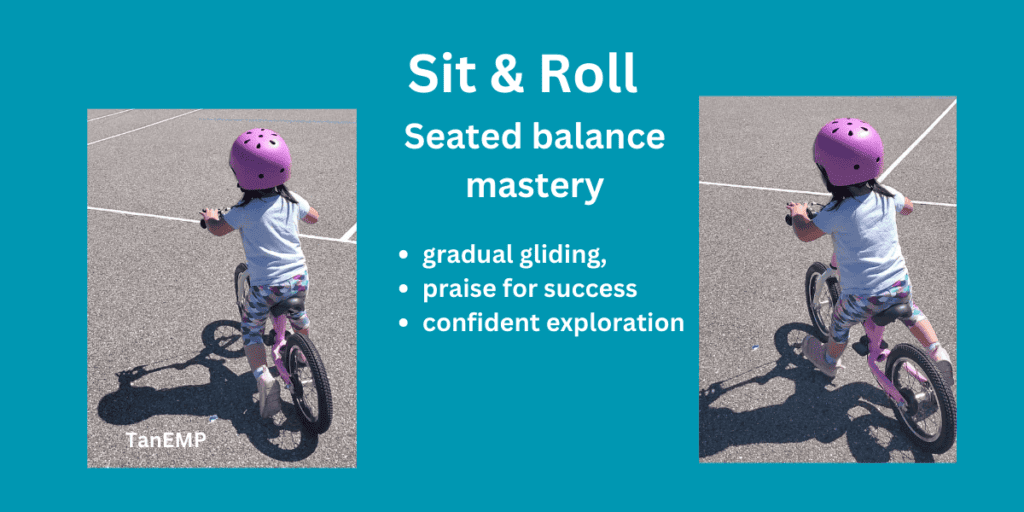
Once your toddler has developed good strength and balance from pushing the bike while standing, they will likely be ready to try sitting on the seat.
Make sure to adjust the seat height properly so their legs are slightly bent when their feet are flat on the ground.
Most kids can progress to this stage at age 2 to 3.
Have them sit comfortably with their feet flat on the ground and glide short distances to practice balance.
Give plenty of praise for small successes to build self-reliance.
Coasting while sitting teaches your child to start balancing for smoother riding. Let them explore at their own pace, even if it’s just rolling inches at a time.
Mastering balance in a seated position is key before pedals are added down the road.
- Progress to a seated position for a smoother ride
- Glide short distances and build up slowly
3. Stride: Sit and Run (2 to 4 years)
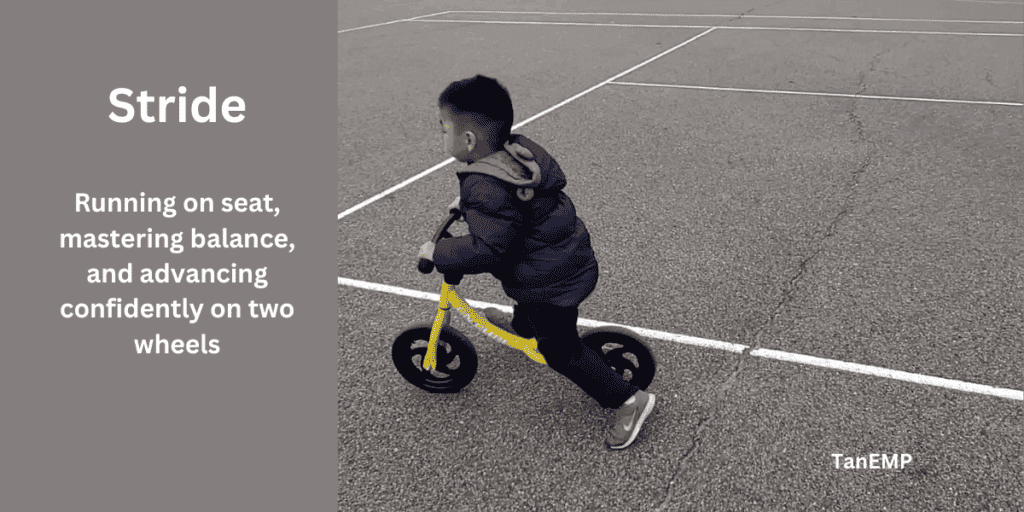
At this stage, your little one should feel at ease getting on and off the balance bike, walking while seated without losing balance, and demonstrating improved steering control.
They become more confident in taking larger steps without losing their equilibrium.
Now, it’s time to introduce the exciting striding technique.
During this phase, your child’s feet remain in contact with the ground, similar to the previous stage, but with the added element of running to build momentum while seated.
Encourage them to gradually take bigger and faster strides.
As they gain momentum, they lift their feet, coasting to see how far they can go before gently placing their feet down again.
This natural process allows kids to discover the principles of balance and steering effortlessly.
Striding not only expands the distance they can smoothly roll through the course.
Incorporate fun into the learning process, turning each stride into a step toward mastering balance, coordination, and steering. Your child’s biking journey has never been more exciting!”
- Master the stride technique: sitting, running, and balancing
- Discover playful ways to improve balance skills
- Build steering and coordination through repetition
4. Glide: Sit and Run (2.5 to 4 years)
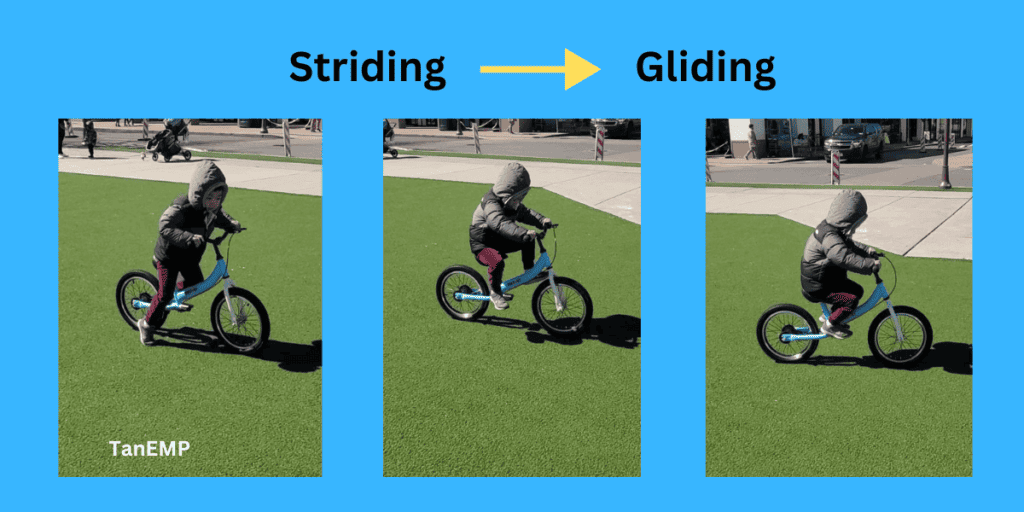
As kids refine their striding technique between 2.5 and 4 years old, coasting and balancing gradually take center stage over running.
Let them focus on the feeling of an effortless, seamless ride. Gliding will start to come naturally as competence grows.
Steady gliding unbroken by footsteps builds real bike handling confidence. Allow them to explore pushing boundaries – gliding faster, farther, around obstacles.
Keep offering encouragement for any small improvements. Glide sessions are now opportunities to discover joy and independence.
- Embrace the art of gliding for a seamless ride
- Explore the world around you with newfound biking skills
- Allow them to push their growing capabilities
5. Transitioning to Pedal Power
Once gliding comes effortlessly on their balance bike, your child is ready for the next stage.
Usually, they are ready to move on to pedal bike between ages 3-5, if they have developed the balance, steering, and coordination from the previous stage.
Start by adding pedals to their balance bike so they can first pedal with their feet still able to touch the ground. This allows them to get used to the motion before fully taking off.
The previous steps set the stage for them to start pedaling without fear of losing balance.
Offer encouragement as they experience the thrill of propelling themselves with pedal power!
- Introduce pedals for an extra burst of biking joy
- Tips for an easy transition to pedaling
- Build pedaling skills while still being able to touch the ground
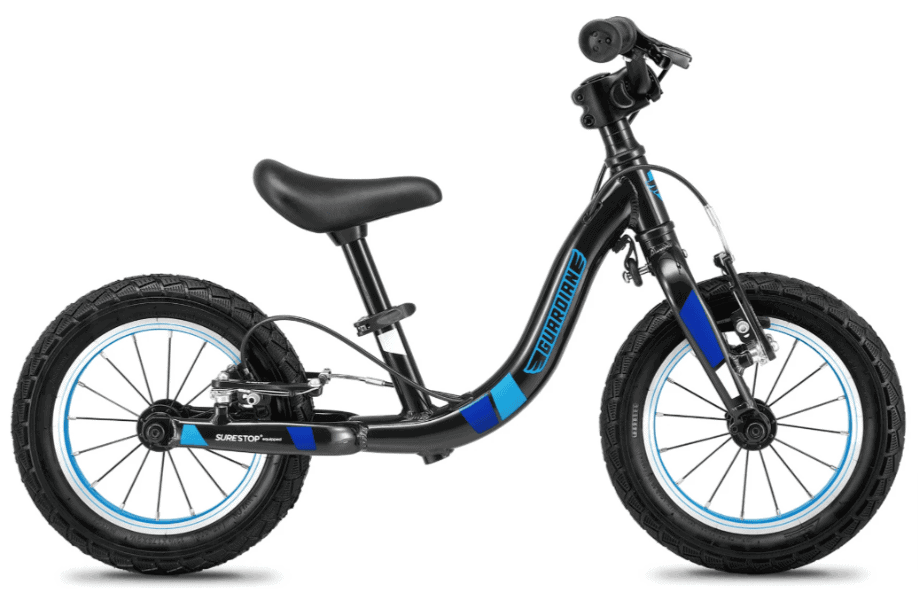
Guardian Highlights
- Best ages for 1.5 to 4
- Weight: 8.5 pounds
- Wheel Size: 12 inches
- Handbrake: yes
- Frame: Lightweight Aluminum
- Features: Steerling Limiter, Air tires, Front & Rear brake
6. Pedal Power Unleashed
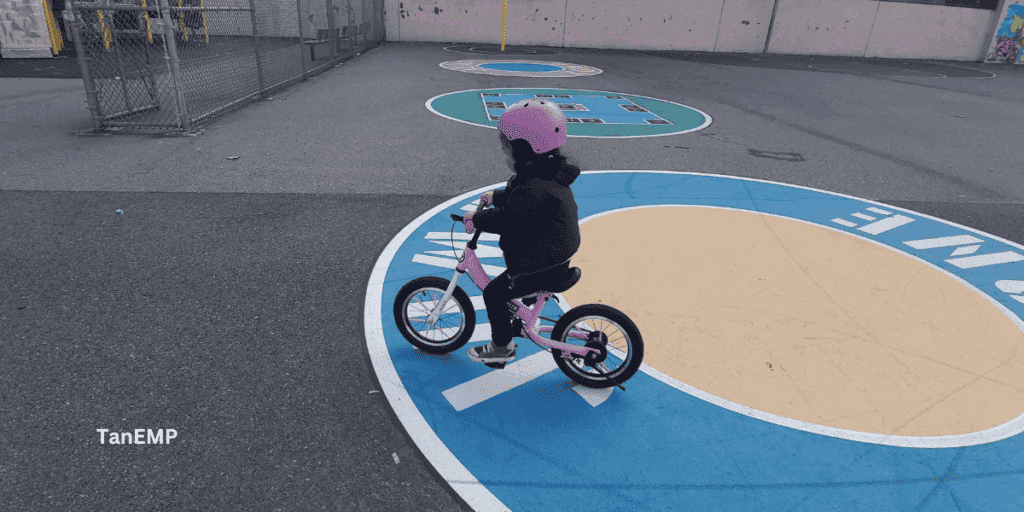
Once your child is comfortable with the newly added pedals to their balance bike, it’s time to unleash that pedal power!
They should have no problem transitioning fully to a pedal bike with good coordination and balance from stage one of the balance bike.
My son’s first step of pedaling is a bit unique in that he walks a bit like how he used to do on a balance bike and he quickly places his feet on the pedals.
No matter their style, your child will discover the fun of propelling themselves faster and farther using pedals instead of their legs.
Stay close by as needed when they test limits, but allow independence to build too.
- Unleash pedal power
- Discover the thrill of speeding and distance
- Build coordination and confidence to ride solo
7. Consistent Practice Pays Off
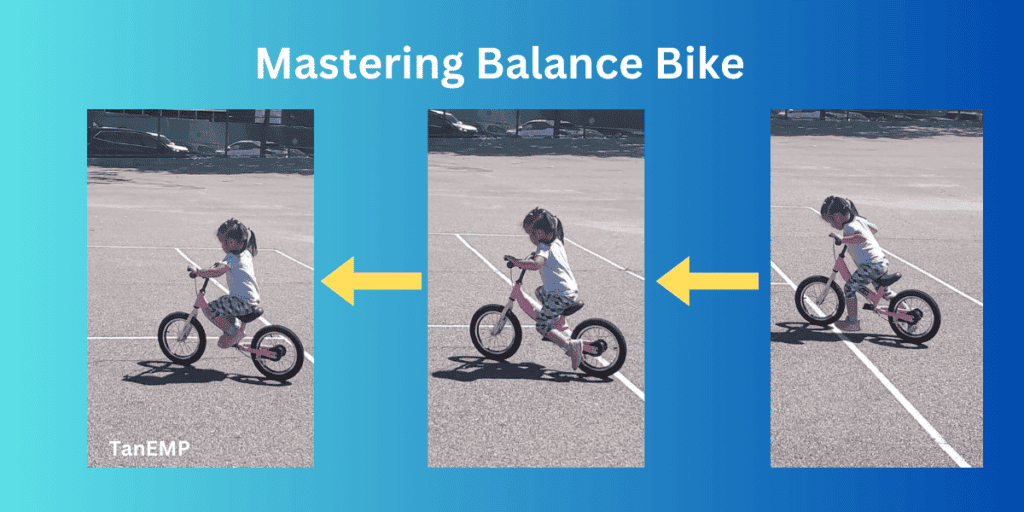
As with any new skill, consistent practice is key to perfection.
Set aside regular time for your child to continue honing capabilities on their balance or pedal bike.
Look for outdoor opportunities like playgrounds, and weekend classes to bring along their bike for short ride sessions.
Praise their effort and growing competence to keep motivation high.
Aim to ride most days if possible, even starting with just 5-10 minutes.
Choosing the right balance bike set up properly for your child’s size and abilities pays off enormously the more frequently they ride.
- Emphasize the value of regular biking practice
- Fun activities to keep the biking enthusiasm alive
- Look for chances to ride during everyday outings
If you purchase through our partner links, we get paid for the referral at no additional cost to you!
How Long Does It Take for My Child to Ride a Balance Bike?
Every child’s journey is unique. My son spent a year and a half mastering the pedal stage, while my daughter achieved it in just one year.
Consistent practice in a safe environment is key to overcoming any fear of injury.
As they become more confident in balancing on the bike, the transition to the pedal stage becomes smoother, allowing you to sit back and enjoy their progress.
Safety pieces of equipment
Always wear a helmet when your kids are riding the bike. especially when they’re at the striding or gliding stage.
It might be tough to keep the helmet on during hot summer weather,
Other essential items you may need are gloves and knee pads.
How Do Kids Stop on Balance Bikes?
Learning to stop a swiftly moving bike is a crucial skill at any stage of the balanced bike journey.
Children instinctively use their feet for stopping, employing either the entire foot, heels, or toes.
My son, for instance, has a unique way of dragging the front part of his shoes to come to a halt. It’s an adorable habit that has taken a toll on more than a few pairs of shoes. His fastest recorded is burning a hold in a new shoe after one ride.
Classic balance bikes typically lack built-in hand brakes to avoid added weight and distractions, models like the Woom 1 and Guardian balance bikes come equipped with brakes for an extra layer of safety.
Conclusion
We hope our guide to balance bikes has given you some great insights on getting your little one ready for the exciting world of bike riding.
Take a peek at our 7 stages to see where your kiddo is at and when it’s time to move on to the next step.
Sharing a bit of our own story, my son stayed a year and a half on his balance bike before leaping to pedal power.
Now, my eager daughter, fueled by the desire to follow in her brother’s bike tracks, jumped to the pedals stage in just a year.
Looking back, I can’t help but wish we’d let her stride and glide on the balance bike a bit longer, building an even stronger foundation and boosting her confidence.
As parents, the key is to resist that urge to rush.
Be patient, enjoy the ride, and let your little adventurers soak up the fun of biking.
Because in the end, it’s not just about reaching the next stage. It’s about savoring every moment along the way.
Happy riding!
FAQ
What age is appropriate for a balance bike?
You can introduce a balance bike to your child as early as 18 months to 5 years old. Make sure to select the right balance bike for their appropriate age.
The earlier you introduce a balanced bike, the faster they learn to ride like a pro.
How do you balance a bike for beginners?
When guiding beginners, especially children, in the art of bike riding, consider introducing them to the wonders of balance bicycles.
These specialized bikes are designed to teach kids how to maintain balance before delving into the complexities of pedaling.
By utilizing a balanced bicycle, you can seamlessly teach your child the essential skills needed for biking, fostering confidence and competence in a fun and effective way.
What is the difference between a regular bike and a balanced bike?
Balance bikes differ from regular bikes as they prioritize teaching kids how to maintain balance while riding.
Unlike traditional bikes with pedals, these specialized bikes focus on building a child’s confidence and coordination, making riding experiences more enjoyable and seamless.
How should legs be on balance bikes?
For optimal control and comfort, set the balance bike seat height so a child’s legs have a slight bend when seated with feet flat on the ground.
This allows them to comfortably push themselves forward using leg power to propel the bike, an important foundation for balanced bike riding skills that kids learn to master before they transition to pedals.
